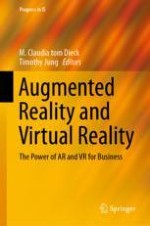2019 | OriginalPaper | Buchkapitel
Immersive Virtual Reality (IVR) in Higher Education: Development and Implementation
verfasst von : Paula Hodgson, Vivian W. Y. Lee, Johnson C. S. Chan, Agnes Fong, Cindi S. Y. Tang, Leo Chan, Cathy Wong
Erschienen in: Augmented Reality and Virtual Reality
Aktivieren Sie unsere intelligente Suche, um passende Fachinhalte oder Patente zu finden.
Wählen Sie Textabschnitte aus um mit Künstlicher Intelligenz passenden Patente zu finden. powered by
Markieren Sie Textabschnitte, um KI-gestützt weitere passende Inhalte zu finden. powered by
